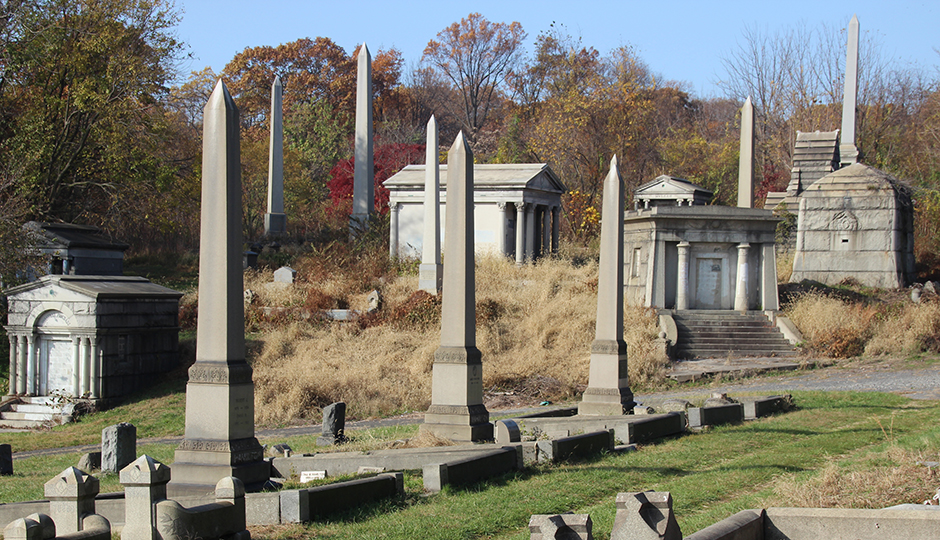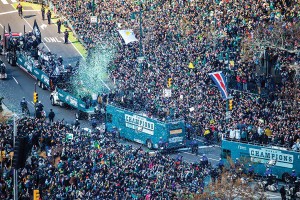What Happens When a Cemetery Dies?

Photograph by David Huisken
Paulette Rhone dared the truck to run her over. She watched the white pickup pull through the front gate at Mount Moriah Cemetery, the trunk overflowing with landscape debris. The two drivers were looking to dump their trash bags, which was not an uncommon occurrence after the cemetery closed its doors. But on this warm spring day in 2012, Rhone, president of the Friends of Mount Moriah, was having none of it.
The 61-year-old blocked the truck at a nearby intersection, not 50 yards from where her husband, Gilbert, was buried in 1993. Rhone, who despite having a warm, motherly smile, could be intimidating when she wanted to be. Especially now, when flanked on either side by Donna Morelli and Ken Smith, both members of the Friends. Her young grandson was there, too.
The would-be dumpers played it cool at first, saying they were visiting family. Morelli got off her ATV and approached the driver’s window, mini sledgehammer in hand. “You’re gonna take this stuff home first,” she said.
The two men didn’t take kindly to being told what to do. “We’ll run you over,” one threatened.
Morelli, a 44-year-old whose tattooed arms and biker-gang ties give her the aura of a Wild West outlaw, went on. “You’re disrespectful! There’s veterans buried here. You’re going to hell!” She would have smashed their windshield in, had Rhone’s grandson not been there.
“Well, I need to go past you so I can go.”
“No,” Rhone said. “Back up and turn it around.”
“I’ll run you over.”
Rhone, a short, sturdy woman who normally exudes calm and thoughtfulness, stood firm. “Not today you won’t,” she said.
Rhone was not going to budge. How could she? Not with her husband buried in that ground, along with more than 150,000 others of nearly every faith, color and class. Not where she had spent countless hours weed-whacking and clearing overgrowth, so that people who owned plots might be able to once again bury their loved ones. Rhone grew up north of the cemetery along Cobbs Creek Parkway. She had dreams of using Mount Moriah, one of the largest cemeteries in Pennsylvania, to help revitalize her childhood neighborhood. The community, she thought, needed a center. “I knew it would take something like a large parcel, be it green space or water, to bring improvements to Southwest Philly,” she says. The cemetery was always right there, hiding in plain sight amidst the crumbling row homes and salvage yards. It simply needed someone to recognize its potential.
In the end, the two men didn’t run Rhone over. She wouldn’t even move to let them turn around. The truck backed the entire way out.
•
NOBODY EXPECTS a cemetery to die. That’s the business of people. But in April 2011, Mount Moriah flatlined after about 30 years on life support thanks, in part, to chronic mismanagement. Grass began to grow, trapping the Victorian monuments and mausoleums in a powerful embrace. Headstones that had once stood majestically became invisible, absorbed by forest.
It was a far cry from the founding years, when Mount Moriah was an immaculate landmark, occupying 54 acres of farmland undisturbed by the bustling city. Founded in 1855, the cemetery was described by its then-president, Robert P. King, as a place where “no dissonant sound falls upon the ear, and the contemplation of the visitor is never discomposed.” In those days, families would visit its rolling hills by horse carriage. A trolley would carry caskets to the burial sites.
Over the years, Mount Moriah grew to roughly 200 acres (some estimates go as high as 380), spanning both Philadelphia and Delaware counties. By the end, it was simply too large to maintain. When the gates finally closed in 2011, the cemetery was virtually bankrupt. It barely had $10,000 in the bank. Mount Moriah was handed its own death certificate.
But cemeteries can be reborn. Look no further than the Knights of Pythias Greenwood cemetery in Northeast Philly. In 2008, Cancer Treatment Centers of America acquired the dilapidated 44-acre property, built a parking lot over some of the land, and agreed to spend over a million dollars to rejuvenate the rest. Four years later, the stray tires and slabs of cement were cleared, and the first new burial occurred.
If all goes according to plan, Mount Moriah, thought to be the largest cemetery ever abandoned in the United States, will also come back to life. Though the cemetery currently has no legal owner, the city of Philadelphia recently sorted out the complicated member of stewardship; now, the seven-member Mount Moriah Preservation Corporation has the power to handle the cemetery’s business affairs. A member of both the MMPC and the Friends, Rhone acts as an integral coordinator between the two non-profits.
Ultimately, Rhone envisions what she calls “managed chaos” – Mount Moriah will retain its wooded feel, but the plants won’t be as invasive. She knows the land can have many uses: People can visit family, look for rare birds and trees, run and bike. But appealing to everyone requires a tightrope act – she wants to make sure this is first and foremost a place for the neighborhood. “We have to be very careful in what we do,” she says.
•
A LITANY of obstacles stood in the way of the Friends when they began their work in 2011: trash dumping, drugs, prostitution, even wild dogs. There was nobody patrolling or taking care of the grounds. Criminals once ditched and torched a getaway car inside the gates after a shooting.
The first order of business was to figure out how to scare off criminals. Morelli, who lives next to the cemetery, became its self-appointed security guard. She told people the grounds were haunted and created a Facebook page named “Haunt Mount Moriah.” “I was trying to scare people out of here at the time so I could catch the dumpers,” she explains.
Morelli – whose late husband was a member of the Warlocks motorcycle club – also earned a reputation within the neighborhood as a “crazy white girl on a quad with a gun riding around.” She would frequently spend nights cruising the grounds on her ATV, wearing bizarre hats with goggles and mismatched shoes in order to scare people off. Despite contracting Lyme disease from the cemetery’s ticks and losing her ability to work as a tattoo artist, Morelli still patrols the cemetery nearly every night, albeit without her gun (she’s currently on probation for carrying a firearm without a valid license).
These days, the cemetery is much safer. Morelli is almost confounded by the change. Her brand of security is abrasive and in-your-face, and while she intends to get her permit back, she also admits that her tactics don’t exactly mesh with the sort of security the cemetery needs now. “Right now, our biggest problem, as far as illegal things, is people walking their dogs off the leash,” she says. “It’s one of those things I don’t even know what to do with. They’re not really criminals.”
That’s evident on a recent June afternoon, as Mount Moriah is positively idyllic. The air is filled with chirping birds and the soft footsteps of deer, punctuated by the occasional squeal of police sirens—the only reminder you are still in the city. The grass is neatly trimmed thanks to Ken Smith, whom despite working a 9-to-5 job as an investment advisor, shows up every morning at sunrise and cuts grass for three hours, before heading into his office. Rhone, a retired Bureau of Labor Statistics analyst, takes the dayshift. She’s there everyday until 1 p.m.; on weekends she frequently stays until it’s dark.
Today, Rhone is cooling off in the shade next to one of the highlights of the cemetery—the Circle of St. John, a hill that offers an unobstructed view of the skyline and is dotted with monuments, including a 35-foot Corinthian column topped by a Masonic emblem. The Circle is a prime example of the contradictions of Mount Moriah. It’s completely cleared, but surrounded by massive overgrowth just a few steps away. The monuments are imposing and grand, but also display traces of faded graffiti.
After her cool-down, Rhone drives down to the cemetery’s main thoroughfare, in search of a grave. Because the Friends have been so adept at clearing the cemetery their primary role has shifted. “We’ve gone from being the lawn care service to being management,” Rhone says. Today she is helping a woman who posted on Facebook that she was searching for a relative, Charles Thomas Galbraith, who was buried in 1953. Rhone is prepared for the scavenger hunt, wearing a plain gray shirt and black pants, clothes that can handle a beating should she need to tramp through overgrowth. A large sombrero sits loosely on her head, blocking the sun. She pulls up a map on her iPad, along with the database the Friends have been compiling from the cemetery’s old records. “If you see ‘Myers’ or ‘Fulmore,’” Rhone says, gesturing to two nearby headstones, “that’ll tell you you’re sort of in the right area.”
Mount Moriah is changing—joggers, bikers, birders, and adventurous explorers have all started to come from afar to visit the cemetery. Few, if any, are African American, unlike much of the surrounding neighborhood. On a recent tour led by the Friends, everyone is white, and the group draws puzzled glances from passersby on Kingsessing Avenue. “Not only do you see people who are not of color walking in the cemetery, now you see them walking their dogs outside,” Rhone says. “And that’s been a change this summer.”
Rhone is thrilled to see more visitors coming to Mount Moriah and Southwest Philly. However, she wants to maintain the integrity of the neighborhood. A member of a local community advisory board, she has already met face-to-face with residents, explaining how things could change if the cemetery truly takes off. “You need to get in front of this and make sure that you have a seat at a table and are not on the menu,” she told them, “so that you know what you want and what you don’t want for this community.”
Ultimately, it is impossible to predict what may or may not happen outside the gates of Mount Moriah. On the inside, however, Rhone’s vision is crystal clear. Rebuilding projects, a planting scheme and maintenance plan, achieving arboretum status and securing a spot on the National Register of Historic Places. These aren’t pipe dreams: Thanks to a $22,000 grant from the Mayor’s Fund, an additional $11,000 that came from fundraising, and a well-organized group of volunteer grant writers, these projects are in motion.
Perhaps most importantly, Rhone is working to honor the plots Mount Moriah sold to families before it closed. There is a man, for instance, now in his nineties, who came and cleared his wife’s plot for forty years, through all the bad times when nobody else cared about the cemetery. The plot has space for him. Rhone wants to make sure he can be buried next to his wife. Rhone also wants to make sure that she can be buried next to her husband.
•
SHE’S STANDING there now, next to the reddish-brown grave where Gilbert Rhone was buried 23 years ago, nearly to the day. By then, the cemetery was nearing the end of its own life.
Paulette drove on Kingsessing in the limousine that day and noticed the cemetery’s fence was lopsided, thinking to herself, “Boy, this looks a little rough.” She stopped at the main office and was handed a key in exchange for a check. She remembers what the woman wore: black skirt with trumpet pleats. The rest is a blur.
Rhone believes things happen for a reason. “If he wasn’t here, I wouldn’t be here,” she says. And so on that day, the day Gilbert was buried, there was also the faint glimmer of something else: A beginning.


